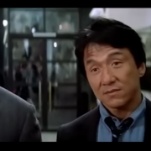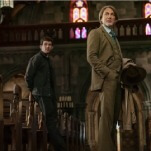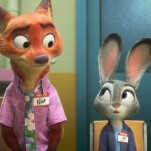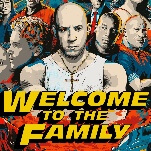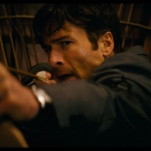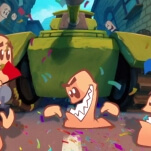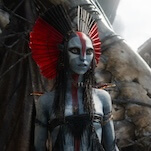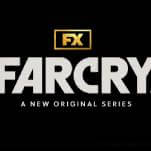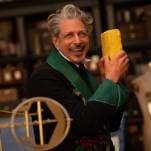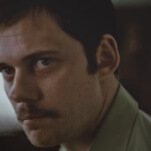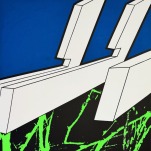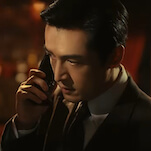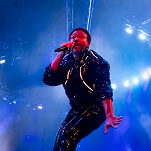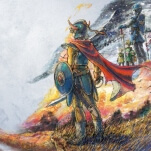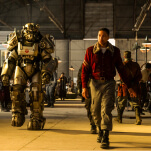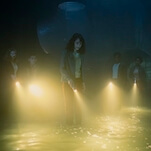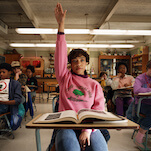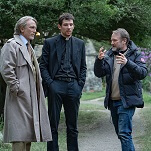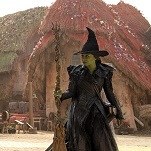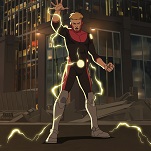The late crime novelist Donald E. Westlake was notably protective of his most prominent fictional creation, the hard-as-nails master thief Parker, who starred in more than two dozen books written under Westlake’s major pseudonym, Richard Stark. Though the Parker books were adapted into films seven times, including the acclaimed Point Blank, Westlake insisted that the filmmakers change Parker’s name if they weren’t going to bother with a faithful rendition of the series. It’s a signal of both Westlake’s approval and Darwyn Cooke’s intentions, therefore, that Cooke’s graphic-novel adaptation of the first book, Richard Stark’s Parker: The Hunter (IDW), gets to give its protagonist the right name. Developed in collaboration with Westlake before his 2008 death, The Hunter is pitch-perfect in capturing not just the story, but the lean, gritty noir spirit of the original novel, starting with the classic opening line, “When a fresh-faced guy in a Chevy offered him a lift, Parker told him to go to hell.” A long, largely wordless sequence introducing Parker highlights that Cooke both knows the original story inside-out, and knows how to retell it in a new way. Cooke’s noir bona fides include the 2003 Catwoman story Selina’s Big Score and the 1950s-set DC: The New Frontier, which also captured his aptitude for mid-century design aesthetics. Here, he creates a black-and-cool-blue early-’60s New York that’s both evocative and appropriately unglamorous. Cooke reportedly plans to continue adapting at least the next three Parker books; based on this one, it’d be a crime if he didn’t… A
Given how long David Mazzucchelli has been working in the comics industry, it’s hard to believe that Asterios Polyp (Pantheon) is the 48-year-old illustrator’s first solo graphic novel. Less surprising? Asterios Polyp is an instant classic, belonging on the list of the medium’s greatest long-form achievements. Mazzucchelli is as much a theoretician as he is a storyteller, and Asterios Polyp balances those two sides masterfully, running a cast of multidimensional characters through a sprawling plot designed to delineate competing aesthetic-value systems. In one corner: the title character, a brilliant architect and professor renowned for his ability to turn each design into an intricate statement on human duality. In the other corner: Asterios’ wife, Hana, a sculptress who favors curves, gradation, and clutter. Mazzucchelli uses a mix of drawing styles—some abstract, some realistic, and some almost Disney-esque in their cartoony expressiveness—alongside puckish storytelling gambits that owe a debt to Italo Calvino and Norton Juster. He jumps around in time to fill in his characters’ backstories, all in ways that advance his arguments without alienating readers who just want to find out what happens next. Mazzucchelli introduces images and ideas that take on added meaning once the book is complete, but what’s most brilliant about Asterios Polyp is that it can be enjoyed simply as a collection of indelible moments. In among the debates about how artists should arrange their lives are such emotionally affecting passages as a 10-page spread where Asterios reflects on Hana’s wonderfully mundane physical presence in his life, or several sequences where a wandering Asterios meets a happy collective of backwater patriots, New Agers, and anarchists. Heck, readers could spend a productive hour just analyzing the design of Asterios Polyp’s jacket logo, in which no individual element makes sense without the whole. This is a book that rewards that kind of scrutiny, because the author has given every page and every line his full attention. Yet it doesn’t feel overly fussy or stuffy either; there’s a fair amount of “grip it and rip it” to Mazzucchelli’s approach too, as he inserts gags, follows digressions, or fills pages with pretty pictures just because he can. There are a number of methods at work here, in tension and in harmony. And that’s what Asterios Polyp is all about… A
Most people these days are familiar with Philip K. Dick’s novel Do Androids Dream Of Electric Sheep? as the source material for Ridley Scott’s Blade Runner, but beyond character names and a handful of basic plot elements, the two don’t have much in common. The novel, which deals with the author’s usual themes of personal alienation, technical disconnect, and the role of religion in the modern world, deserves a chance to stand on its own, so it’s nice to find that the latest adaptation, a 24-issue comic-book maxi-series from BOOM! Studios, stays close to the source. It might be a little too close, actually. Do Androids Dream Of Electric Sheep #1 (BOOM! Studios) doesn’t adapt Dick’s work so much as transplant it, shoehorning all the original text into word boxes and balloons, surrounding it with illustrations that are by turns reductive, redundant, and even, on occasion, clarifying. Breaking some of Androids’ trickier passages into bite-sized chunks makes Dick’s philosophical ramblings easier to process, but the lack of abridgment makes the comic sluggish, and the first issue ends without any real momentum to encourage readers to pick up No. 2. With some careful pruning of descriptive passages, this could’ve stood on its own; as is, it’s compelling only as an experiment, and new readers would be better off sticking to the original… B-
Blackest Night #1 (DC) kicks off yet another “nothing will ever be the same” companywide crossover, and in predictable fashion, the first issue largely consists of popular and obscure heroes alike standing around reminding each other of every awful thing that’s happened over the past decade-plus of DC continuity. Yet there’s also a sense of urgency and emotional heft to Geoff Johns’ writing here, and a sense of grandeur to Ivan Reis and Oclair Albert’s art that makes Blackest Night more immediately appealing than other, similar DC events. The first issue begins on an annual day of mourning, when everyone around the DCU takes a moment to remember fallen heroes (and in the case of Flash’s Rogues, villains). As Johns moves from locale to locale, he establishes the story’s stakes in a meaningful way, such that when a storm of Black Lantern rings rains down on the Earth and the dead begin to rise, the moment is effectively creepy. But then Johns has to go and spoil all the goodwill he’s built up over the first 34 pages by literally digging up the bones of some unfairly abused DC characters in order to ravage their memory all over again. Blackest Night #1’s concluding pages are admittedly stunning, and the overall story still holds a lot of promise. But the DC creative stable’s cheap shock effects are getting cheaper by the month, and it’s hard to keep shrugging off the disgust factor… C-
By now, those who have encountered Kazu Kibuishi’s Flight anthologies should be pretty clear on what they’re getting with each new volume, and whether they’re fans. In that sense, Flight Volume Six (Villard) is nothing new: It’s another collection of vividly colorful, beautifully painted, not always narratively satisfying short stories largely created by graphic designers, animators, storyboard artists, professional illustrators, newcomers to the field, and other people without extensive comics backgrounds. The emphasis is again on design and on stunning imagery more than anything else. There are several familiar threads here: Michel Gagné continues the interplanetary adventures of his little fox-beastie Rex, Kibuishi chimes in with another Daisy Kutter story, Kean Soo provides another Jellaby story, and Steve Hamaker brings back his odd heroes-for-hire Fish and Chips. (Chips is an anthropomorphic cat; Fish is a fish in a bowl, controlling a robot suit wearing that bowl as a head.) While all that is fun—Gagné’s sweet cartooning and eye-popping coloring is still astonishing, even among such talented company, and it’s always a thrill to see more of Kibuishi’s accomplished work—the book’s on-offs have more energy and daring, and are more startling in their ambition. In particular, Cory Godbey’s “Walters” could stand alone as a fantastic picturebook, or better yet, posterbook. A deeply sentimental—even cloying—riff on the flight of Larry Walters, the guy who took flight in a lawn chair attached to balloons, inspiring the movie Danny Deckchair among other things, Godbey’s piece celebrates flight, the human spirit, and the will to overcome fear. But even moreso, it celebrates glorious, glorious color, via images that practically serve as poems… B+
The first few pages of Sam Kieth’s My Inner Bimbo (Oni) are confusing enough in their fractured, unclear point of view to serve as a barrier: “You must be this intelligent to enter.” (Or maybe just “this determined.”) Even once things become clearer, the fantastically dense pages and equally dense layers of symbolism and shifting perspective require concentration, as Kieth pulls readers down the kind of a rabbit hole of perception vs. fantasy that marked this other signature surreal works, The Maxx and Zero Girl. The story follows a middle-aged male schlub named Lo whose “feminine side” develops a full-blown personality, presence, and mythic backstory. At first she’s a voice in his head, then—apparently thanks to the intervention of a magical trout and a homemade mystical box—she enters the world. At first she’s Lo’s dim-witted fucktoy, taking the edge off his miserable marriage. Then she becomes increasingly personally and politically aware, though she’s still sometimes a voice in his head, sometimes a companion by his side, and sometimes his physical replacement. As with The Maxx, Kieth (who scripted and did layouts for assistant artists Leigh Dragoon and Josh Hagler) constantly elides over the question of what’s real and what’s in Lo’s head, and if things ever seem clear, he deliberately muddies the waters. (For instance, other people have encountered the Mysterious Trout and built magic boxes of their own. Through this plot thread, the book loosely connects with Kieth’s book Ojo.) His deconstruction of sexual appetites, obsessions, inhibitions, prejudices, stereotypes, and fantasies often seems achingly personal, like getting stuck in the sticky complexity of someone else’s subconscious… B+
From 1913 until his death in 1954, George McManus wrote and drew the comic strip Bringing Up Father, about a nouveau riche Irishman named Jiggs and his social-climbing wife Maggie. NBM’s latest “Forever Nuts” volume, George McManus’s Bringing Up Father, collects the strip’s first two years, when McManus was tinkering with the design of the characters and the formula for his jokes. But it didn’t take long for that formula to fall into place: Maggie tries to keep Jiggs clean and sober for some fancy affair; Jiggs manages to sneak out for booze; embarrassment and physical violence ensues. Unlike recent reprint projects for Dick Tracy, Little Orphan Annie, and Gasoline Alley, the collected Bringing Up Father doesn’t reveal a rich, engrossing comics masterpiece. This is strictly gag-a-day stuff, noteworthy for the period detail and for the way McManus could wring laughs out of Jiggs’ hunched-over pose, down-turned mouth, and proto-W.C. Fields asides. But the gags are funny and well-designed, with a freewheeling spirit that’s held up well over the past century… B
Having had some success with its deluxe hardcover reissues of the legendary horror anthology Creepy, Dark Horse has decided to simply reboot the title with a mix of new and old material for a summer try-out. (An Eerie revival is also on its way.) Creepy Comics #1 is a pretty entertaining way to kick things off, and should appeal to any and all fans of horror tales, not just old-school revivalists. The cover, a gorgeous piece of work by The Goon’s Eric Powell, is a companion to the feature story inside, “Hell Hound Blues,” by Dan Braun and Angelo Torres; their interpretation of the old Robert Johnson legend is one of the book’s strongest stories. The rest of the book is hit (Joe Harris and Jason Alexander’s “The Curse” and Saskia Gutekunst’s art in “Chemical 13”) and miss (“All The Help You Need” and “Loathsome Lore”), but it makes up for the lesser stories with some great Bernie Wrightson pinups and a reprint of a great Alex Toth story from the old Creepy called “Daddy And The Pie.” Definitely worth picking up, especially since the next issue won’t appear until October… B+
Back in the ’80s heyday of Hate and Neat Stuff, it didn’t seem like Peter Bagge would be the one indie comics artist of his era to become a political cartoonist. And yet here we are in 2009, with Everybody Is Stupid Except For Me And Other Astute Observations (Fantagraphics). Collecting 10 years’ worth of cartoons originally done for Reason magazine, as well as a few odds and sods, the book finds Bagge as sharp and irate as ever, and his art has improved while still being recognizably his own. Bagge is also, thankfully, still possessed of a great sense of humor, especially about himself—even the title reveals an element of self-mockery among all the self-righteousness. But don’t get it twisted: Bagge is hard to pin down (he’s a soft left-libertarian, a species that’s getting harder and harder to find in the wild), but reader’s individual reactions to the strips collected here depend on how much they agree with his choice of targets. And since those targets are fairly wide-ranging, almost anyone reading it is bound to get offended somewhere, which is certainly exactly what Bagge is hoping for…B-
Available since last year in a hardcover edition, Kurt Busiek’s Astro City: The Dark Age (DC/Wildstorm) has finally come out in a softcover trade paperback edition, which is a good thing for budget-minded collectors since the HC added no new material worth the high cover price. For those who have been following Astro City all along, “Dark Age” is one of the most anticipated story arcs in ages; it promises to fill in a lot of the mysterious gaps in the history of Astro City while telling the story of two brothers who follow opposite paths in the superhero-packed world Busiek has created. “Dark Age” also finally tells the story of the Silver Agent, whose mysterious fate Busiek and artist Brent Anderson have been hinting at since the series debuted. It’s a winning entry, and the Silver Agent’s story in particular is worth waiting for, perfectly suiting the mood of Busiek’s loving tribute to the human side of the Silver Age. New fans, though, should be warned: “Dark Age” probably isn’t the best place to jump into Astro City, since it’s pretty steeped in previously introduced elements of the series’ mythology…B+
Comics legend Will Eisner was productive well into his 80s, and continued producing graphic novels until just before his 2005 death. Some of them have become hard to find, so kudos to publisher W.W. Norton for reissuing a number of them. Unfortunately, the best of them have already been reissued, and the ones that remain tend to vary wildly in quality. The latest to come out, A Family Matter and Minor Miracles (W.W. Norton), are definitely proof of that. The former, from 2000, is a dramatic story of a Jewish patriarch whose family tries to figure out how they’re going to carry on after the inevitable death of the powerful figure who has guided their entire lives; the story is a bit mundane, and the characters never much rise above type, but the neo-noir artwork is handsome.The second book is an improvement, but still a mixed bag; 1998’s Minor Miracles is an assortment of short stories—mostly told through narrative captions rather than dialogue, giving them an odd fairy-tale quality—likewise about the lives and loves of Jewish immigrants. They vary wildly in quality; the best of them can stand with Eisner’s finest work, but the least of them are spare and feel hasty. Both of these contain good work, but are more for Eisner completists than for casual readers. A Family Matter: C; Minor Miracles: B




